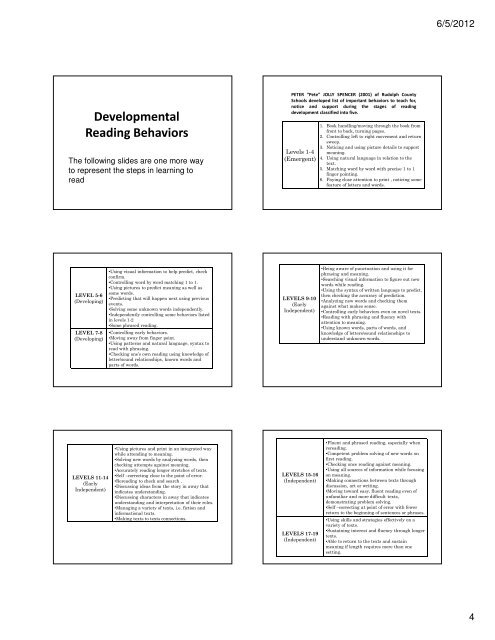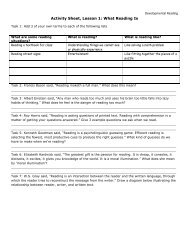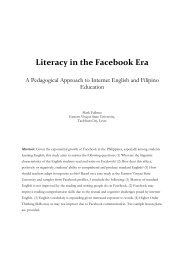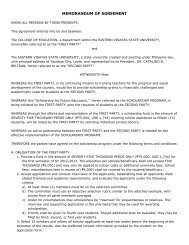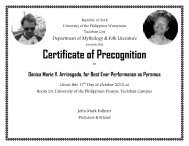PDF handout of the 32 Powerpoints - Mark Fullmer
PDF handout of the 32 Powerpoints - Mark Fullmer
PDF handout of the 32 Powerpoints - Mark Fullmer
You also want an ePaper? Increase the reach of your titles
YUMPU automatically turns print PDFs into web optimized ePapers that Google loves.
6/5/2012DevelopmentalReading BehaviorsThe following slides are one more wayto represent <strong>the</strong> steps in learning toreadPETER “Pete” JOLLY SPENCER (2001) <strong>of</strong> Rudolph CountySchools developed list <strong>of</strong> important behaviors to teach for,notice and support during <strong>the</strong> stages <strong>of</strong> readingdevelopment classified into five.Levels 1-4(Emergent)1. Book handling/moving through <strong>the</strong> book fromfront to back, turning pages.2. Controlling left to right movement and returnsweep.3. Noticing and using picture details to supportmeaning.4. Using natural language in relation to <strong>the</strong>text.5. Matching word by word with precise 1 to 1finger pointing.6. Paying close attention to print , noticing somefeature <strong>of</strong> letters and words.LEVEL 5-6(Developing)LEVEL 7-8(Developing)•Using visual information to help predict, checkconfirm.•Controlling word by word matching 1 to 1.•Using pictures to predict meaning as well assome words.•Predicting that will happen next using previousevents.•Solving some unknown words independently.•Independently controlling some behaviors listedin levels 1-2•Some phrased reading.•Controlling early behaviors.•Moving away from finger point.•Using patterns and natural language, syntax toread with phrasing.•Checking one’s own reading using knowledge <strong>of</strong>letter/sound relationships, known words andparts <strong>of</strong> words.LEVELS 9-10(EarlyIndependent)•Being aware <strong>of</strong> punctuation and using it forphrasing and meaning.•Searching visual information to figure out newwords while reading.•Using <strong>the</strong> syntax <strong>of</strong> written language to predict,<strong>the</strong>n checking <strong>the</strong> accuracy <strong>of</strong> prediction.•Analyzing new words and checking <strong>the</strong>magainst what makes sense.•Controlling early behaviors even on novel texts.•Reading with phrasing and fluency withattention to meaning.•Using known words, parts <strong>of</strong> words, andknowledge <strong>of</strong> letters/sound relationships tounderstand unknown words.LEVELS 11-14(EarlyIndependent)•Using pictures and print in an integrated waywhile attending to meaning.•Solving new words by analyzing words, <strong>the</strong>nchecking attempts against meaning.•Accurately reading longer stretches <strong>of</strong> texts.•Self –correcting close to <strong>the</strong> point <strong>of</strong> error.•Rereading to check and search .•Discussing ideas from <strong>the</strong> story in away thatindicates understanding.•Discussing characters in away that indicatesunderstanding and interpretation <strong>of</strong> <strong>the</strong>ir roles.•Managing a variety <strong>of</strong> texts, i.e. fiction andinformational texts.•Making texts to texts connections.LEVELS 15-16(Independent)LEVELS 17-19(Independent)•Fluent and phrased reading, especially whenrereading.•Competent problem solving <strong>of</strong> new words onfirst reading.•Checking once reading against meaning.•Using all sources <strong>of</strong> information while focusingon meaning.•Making connections between texts throughdiscussion, art or writing.•Moving toward easy, fluent reading even <strong>of</strong>unfamiliar and more difficult texts,demonstrating problem solving.•Self –correcting at point <strong>of</strong> error with fewerreturn to <strong>the</strong> beginning <strong>of</strong> sentences or phrases.•Using skills and strategies effectively on avariety <strong>of</strong> texts.•Sustaining interest and fluency through longertexts.•Able to return to <strong>the</strong> texts and sustainmeaning if length requires more than onesetting.4


